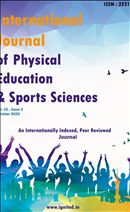Effect of Proprioceptive Training on Foot Pressure Distribution and Stabilometric Performance of Sprinters
Main Article Content
Authors
Abstract
The study was conducted to determine the effect of proprioceptive training on foot pressuredistribution and stabilometric performance of sprinters.To facilitate the study ten female sprinters of the LNIPE match practice group were selected. The selectedsubjects were in the range of 18 to 24 years of age.BTS-P-Walk (Bodopometric platform) was used to collect the data for this study. The subjects were askedto stand still in a normal standing position on the bodopometric platform and data was recorded for a 05-sec duration.The data collected from participants were statistically analyzed by employing paired t-test to examine thesignificant effect of proprioceptive training on the dependent variablesThe result has exhibited that the obtained value of paired t-test has shown an insignificant differencebetween the pre-test and post-test of the female sprinters as the p-value is greater at 0.05 level ofsignificance.
Downloads
Download data is not yet available.
Article Details
Section
Articles
References
- Bompa, T.O. and haff, G.G. (1999)”.Periodization:theory and methodologytraining”, Human kinetics, United States; 5th Ed: 04.
- Gerhard Hochmuth. (1984). “Biomechanics of Athletic Movement”Sportverlag, Berllin: 9
- Hay,J.G. (1973). “The Biomechanics of Sports Techniques”, Prentice Hall Englewood cliffs, New Jersey:2.
- Hall S.J.(1995). “Basic Biomechanics”, McGraw-Hall; third edition: 4.
- Hall, S.J. (2004). “Basic Biomechanics”, McGraw-Hall; 66-67
- Kathryn L. and Hamilton,N. (2002). “Kinesiology: Scientific Basis of Human Motion”, McGraw Hill Higher Education, New York: 262-263.
- McGinnis, Peter. M.(2005). “Biomechanics of Sport and Exercise”, Human Kinetics; United States: Second Edition: 14.
- Peter Merton McGinnis. (2005). “Biomechanics of Sports and Exercise”, Human Kinetic, U.S.A.:289.
- Rai, Ramesh, (2003). “Mechanical Aspects of Human Motion”, Agrim publication Mohali Punjab: 1.
- Reddy, R.V.S.(2002). “Sports Biomechanics”. New Delhi publication: 1.
- Smith, M.F.(2010). “Research Methods in Sports”, Tj International, Great Britain: 1-3.
- Verma, J.P.(2011), “Statistical Methods for Sports and Physical Education”, McGraw-Hill: 161-174.
- Winter, David A.(2005). “Biomechanics and Motor Control of Human Movement”, John Wiley & Sons; third edition: 1.
- Alexander Ruhe, Rene Fejer, Bruce Wlker, (2011). “Center of pressure excursion as a measure of balance performance in patients with non-specific low back paincompared to healthy controls: a systematic review of the literature”. European Spine Journal; 20(3): 358-368.
- Alexander Ruhe, Rene Fejer, Bruce Walker, (2011). “Altered postural sway in patients suffering from non-specific neck pain and whiplash-associated disorder – A systematic review of the literature”. Chiropractic & Manual Therapies; 19:13
- Alice M. Wong, Yin-Chou Lin, Shih-Wei Chou, Fuk-Tan Tang, and Pong-Yeun Wong, (2001). “Coordination Exercise and Postural Stability in Elderly People: Effect of Tai Chi Chuan”. Archives of Physical Medicine and Rehabilitation;82(5): 608-612.
- A Moezy, G Olyaei, M Hadian, M Razi, S Faghihzadeh. (2008). “A comparative study of whole body vibration training and conventional training on knee proprioceptionand postural stability after anterior cruciate ligament reconstruction”. British Journal of Sports Medicine; 42; 373-385.
- Casey A. Reed, Kevin R. Ford, Gregory D. Myer and Timothy E. Hewett. (2012). “The effects of isolated and integrated ‘core stability’ training on athletic performance measures”, Sports Medicine; 42(8); 697-706.
- David E. Krebs, Alan M. Jette and Susan F. Assmann (1998). “Moderate Exercise Improves Gait Stability in Disabled Elders. Archives of Physical medicine and Rehabilitation”; 79(12): 1489-1495.
- Huang PY, Lin CF, Kno LC, Liao JC.(2011). “Foot pressure and center of pressure in athletes with ankle instability during lateral shuffling and running gait”. Scandinavian Journal of Medicine and science in sports; 21(6): 461-467
- Mark V. Paterno, Greg D. Myer, Kevin R Ford, Timothy E Hewett. (2004). “Neuromuscular training improves single leg stability in young female athlete”. Journal of Orthopedic & Sports Physical Therapy; 34(6): 1082-1088
- Min-Chi-Chiu, Hsin-Chieh Wu, Li-TuChaung, Min-Huan Wu.(2013). “Center of pressure progression charecteristics under the planter region for elderly adults”. Gait and Posture; 37(3): 408-412
- Romero Frenco N, Martinez Amat A, Hita Contreras F, Martinez Lopez EJ. (2014). “Short-term effects of a proprioceptive training session with unstable platforms on the monopdalstabilometry of athletes”. Journal of Physical therapy Science; 26(1): 45-51
- Romero Franco N, Martinez Lopez E, Lomas Vega R, Hita Contreras F, Martinez Amat A. (2012). “Effects of proprioceptive training program on core stability and center of gravity control in sprinters”. The Journal of strength and Conditioning Research; 26(8): 2071-2077
- Romero Franco N, Martinez Lopez, Lomas Vega R, Hita Contreras F, Osuna Perez MC, Martinez Amat A. (2013).” Short term effects of proprioceptive training with unstable platform on athletes’ stabilometry”. The Journal of Strength and Conditioning Research; 27(8): 2189-219
- Rene Fejer and Bruce Walker. (2010). “The test-retest reliability of center of pressure measures in bipedal static task conditions – A systematic review of the literature”. Gait and Posture; 32(4): 436-445

